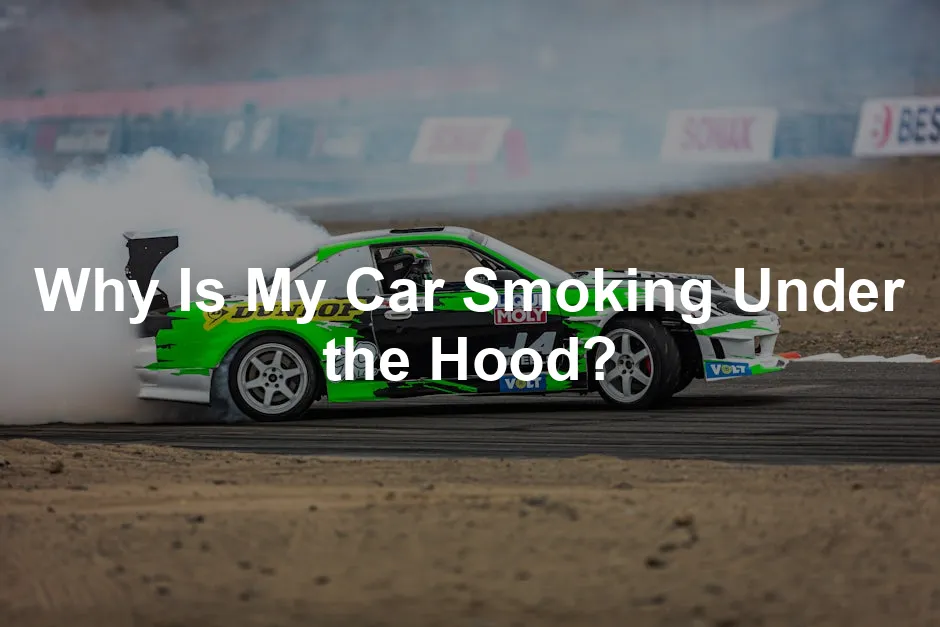
Why Is My Car Smoking Under the Hood?
Typical sources of oil leaks include:
- A damaged oil filter can lead to oil escaping.
- Faulty gaskets may fail to seal properly, allowing oil to seep out.
Ignoring oil leaks can have dire consequences. Low oil levels can result in poor lubrication, causing engine wear and potential failure. It’s essential to address oil leaks promptly to maintain engine health.
And while you’re at it, don’t forget to grab an Oil Filter Wrench. It makes changing your oil filter a breeze!

Electrical Issues
Electrical problems can also lead to smoke under the hood. Short circuits or damaged wiring can generate heat, resulting in smoke.
Symptoms of electrical failures include:
- A burning plastic smell may indicate wires are melting.
- Flickering lights can signal an electrical issue.
These problems pose significant risks. An electrical failure can lead to a fire, endangering both you and your vehicle. Always take electrical smoke seriously and seek professional help if you suspect an issue.
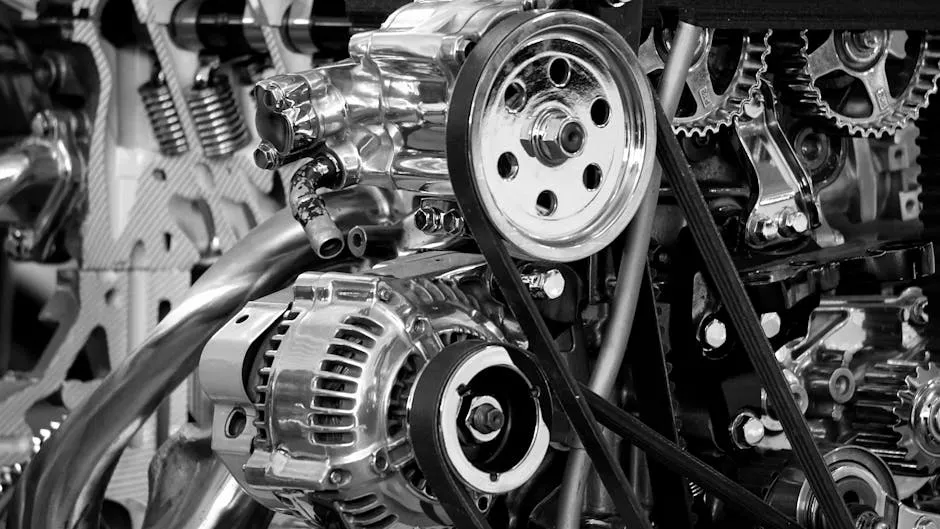
Fluid Leaks (Coolant, Transmission Fluid, etc.)
Fluid leaks are a common cause of smoke under the hood. When fluids, such as coolant or transmission fluid, leak onto hot engine components, they can quickly vaporize and produce smoke. This can create a frightening situation, especially if you’re not sure what’s causing it.
Regular fluid checks are vital. Ensuring your vehicle has adequate fluid levels helps maintain engine health and performance. Neglecting fluid maintenance can lead to severe damage over time.
Identifying fluid leaks is crucial for keeping your car running smoothly. Look for puddles under your vehicle or spots on your driveway. You can also check fluid levels in the reservoir or dipstick. If you notice any drops in fluid levels or suspicious stains, it’s time to investigate further.
And while we’re on the topic of fluids, don’t forget to keep a handy Car Engine Oil in your garage. It’s like the lifeblood of your engine!
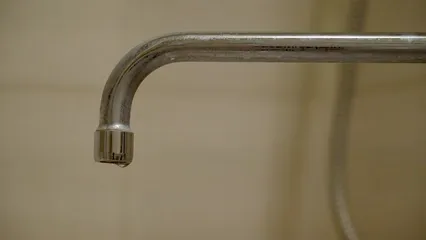
Fuel System Problems
Fuel system issues can also lead to smoke. For instance, malfunctioning fuel injectors might cause excess fuel to enter the engine. When this happens, it can burn improperly, resulting in smoke.
Common signs of fuel system problems include unusual smells, such as a strong gasoline odor. If you notice this, it’s essential to address it quickly.
To diagnose fuel system issues, pay attention to your vehicle’s performance. Is it stalling or struggling to start? If so, these could be indicators of a malfunction. You might also want to check for fuel leaks around the injectors or fuel lines. Regular maintenance, including Fuel Injector Cleaner, can prevent these problems and keep your car running efficiently.
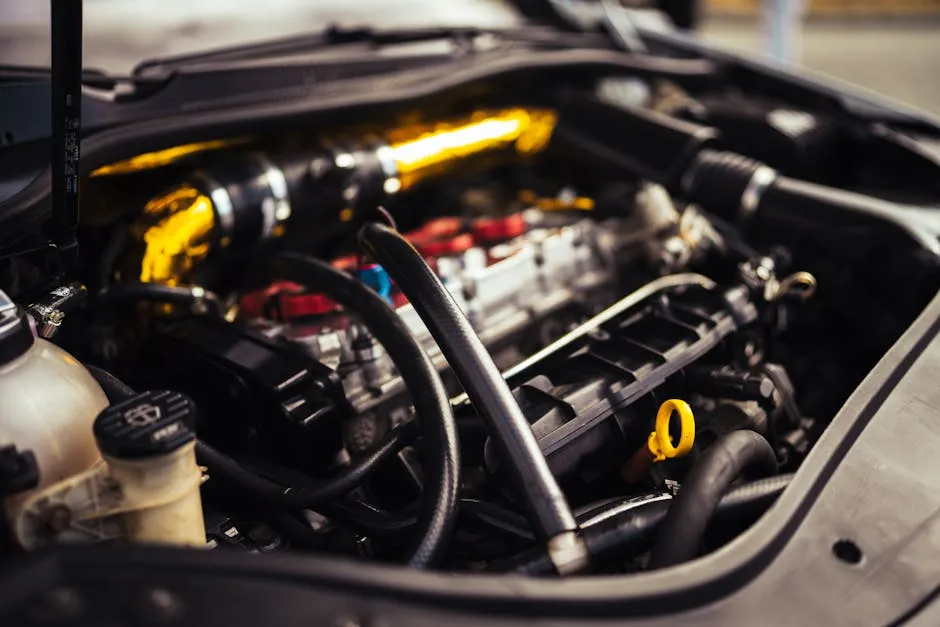
Blue or Gray Smoke
Seeing blue or gray smoke from your car? This usually means your engine is burning oil. It’s a sign that something may be wrong. The most common causes include worn seals or damaged piston rings. These issues can allow oil to seep into the combustion chamber.
Always check your oil levels if you notice this smoke. Low oil can lead to more severe engine problems down the line. Keeping an eye on your oil can save you from costly repairs.
To make checking your oil easier, consider using a Oil Drain Pan. It’s an excellent tool for DIY oil changes!

Black Smoke
Black smoke is another warning sign. It often indicates incomplete combustion in the engine. This typically happens when there’s too much fuel and not enough air. Possible causes include faulty fuel injectors or a malfunctioning fuel pressure regulator.
If you smell gasoline along with the black smoke, it’s a clear indicator of a fuel issue. This could lead to poor engine performance and reduced fuel efficiency. Don’t ignore this warning; addressing it quickly can prevent further damage.
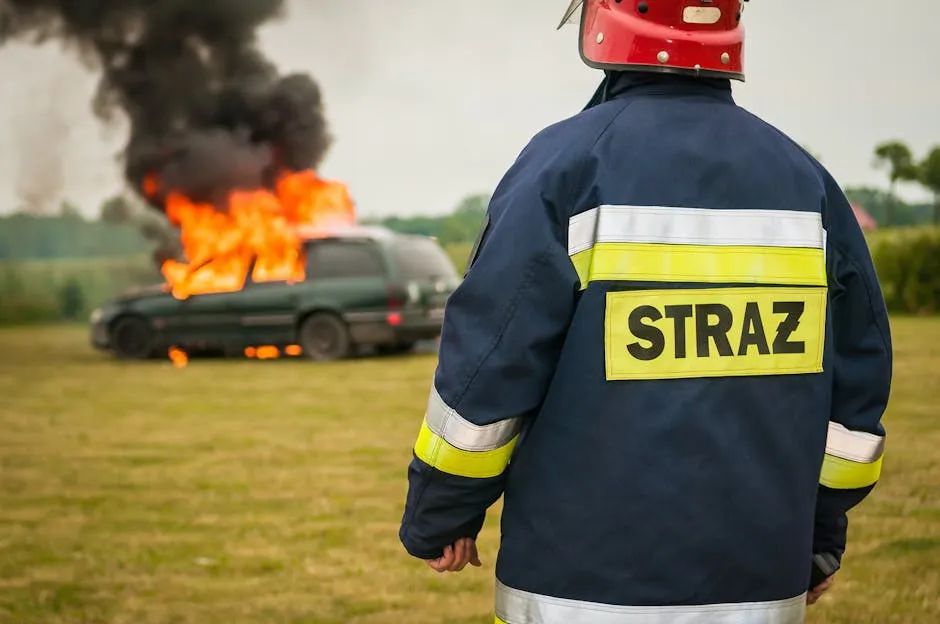
What to Do If Your Car Is Smoking
Pull Over Safely
First things first: pull over as soon as it’s safe. Shutting off the engine is critical. This prevents further damage and allows you to assess the situation. Take a moment to breathe and gather your thoughts. Panic won’t help, but a clear head will.
Inspect the Situation
After stopping, look for any visible signs. Check if there’s smoke coming from specific areas. Is the smoke accompanied by unusual smells? Pay attention to your dashboard. Are there warning lights illuminated?
Monitor your temperature gauge. If the engine is overheating, you need to take action quickly. Checking oil pressure is also crucial. Low oil pressure can indicate more significant problems ahead.
With a quick visual inspection, you can gather valuable information about the issue. If you see fluid leaks or unusual gauges, it’s time to call for help. Don’t take risks with your safety or your vehicle’s health.
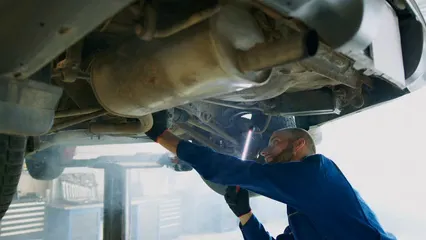
Seek Professional Help
Noticing smoke under your hood? It’s vital to consult a professional mechanic immediately. Ignoring the problem can lead to severe engine damage and costly repairs down the road. A small issue today can escalate into a hefty bill tomorrow.
When you reach out to a mechanic, clear communication is key. Start by describing the symptoms you’ve observed. Mention the color and smell of the smoke. Did you notice any unusual sounds or warning lights? Providing as much detail as possible will help them diagnose the issue faster.
Don’t hesitate to ask questions about the repair process and costs. Understanding the situation will ease your mind and ensure you make informed decisions regarding your vehicle.
And while you’re on the phone, it might be a good idea to mention that you have a Portable Jump Starter in your trunk. You never know when it might come in handy!

Preventive Measures
Regular maintenance is your best line of defense against smoke-related issues. Schedule routine check-ups with your mechanic to keep your vehicle in top shape. This often includes fluid checks, filter changes, and inspections of key components.
Monitor your fluid levels regularly. Check the oil, coolant, and transmission fluid levels. If you notice any drops, investigate further. Leaks can cause significant problems if left unaddressed.
Inspect your vehicle for signs of wear and tear. Look for any leaks under your car or stains on the driveway. Using high-quality fluids and parts can also make a difference. They often perform better and last longer, reducing the risk of issues down the line.
Speaking of high-quality, consider investing in a Bluetooth OBD2 Scanner. It can help you diagnose problems quickly and efficiently, allowing you to stay ahead of potential issues.
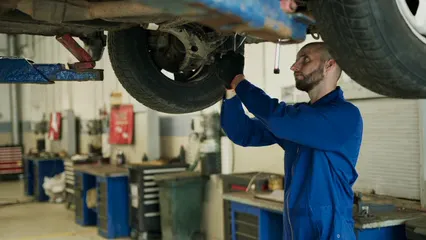
Taking these preventive measures can save you from unexpected smoke incidents and keep your car running smoothly for years.
Conclusion
In summary, smoke under your car’s hood is a serious concern that shouldn’t be ignored. Identifying the cause early can save you from costly repairs and extensive damage. Regular maintenance checks and prompt action are essential in addressing any smoke issues. Stay informed about your vehicle’s health, and don’t hesitate to consult a professional if you notice anything unusual. Your car will thank you for it!
Don’t forget to keep a Car Maintenance Logbook handy to track all your vehicle’s maintenance history. It’s a great way to keep everything organized!
Please let us know what you think about our content by leaving a comment down below!
Thank you for reading till here 🙂
All images from Pexels
Several factors can cause overheating:
- A malfunctioning cooling system may fail to regulate temperature.
- A damaged radiator can leak coolant, causing the engine to overheat.
- Coolant leaks can occur from hoses or gaskets that have degraded over time.
Statistics show that overheating engines account for a significant number of vehicle breakdowns. In fact, around 30% of all engine failures are due to overheating. Catching this issue early is crucial to prevent severe engine damage.
To keep your engine cool, consider using a high-quality Engine Coolant. It helps maintain optimal temperature levels and prevents overheating. Trust me, your engine will thank you!

Oil Leaks
Oil leaks are another common reason for smoke. When oil leaks from the engine, it can drip onto hot components, leading to smoke as it burns.
Typical sources of oil leaks include:
- A damaged oil filter can lead to oil escaping.
- Faulty gaskets may fail to seal properly, allowing oil to seep out.
Ignoring oil leaks can have dire consequences. Low oil levels can result in poor lubrication, causing engine wear and potential failure. It’s essential to address oil leaks promptly to maintain engine health.
And while you’re at it, don’t forget to grab an Oil Filter Wrench. It makes changing your oil filter a breeze!

Electrical Issues
Electrical problems can also lead to smoke under the hood. Short circuits or damaged wiring can generate heat, resulting in smoke.
Symptoms of electrical failures include:
- A burning plastic smell may indicate wires are melting.
- Flickering lights can signal an electrical issue.
These problems pose significant risks. An electrical failure can lead to a fire, endangering both you and your vehicle. Always take electrical smoke seriously and seek professional help if you suspect an issue.

Fluid Leaks (Coolant, Transmission Fluid, etc.)
Fluid leaks are a common cause of smoke under the hood. When fluids, such as coolant or transmission fluid, leak onto hot engine components, they can quickly vaporize and produce smoke. This can create a frightening situation, especially if you’re not sure what’s causing it.
Regular fluid checks are vital. Ensuring your vehicle has adequate fluid levels helps maintain engine health and performance. Neglecting fluid maintenance can lead to severe damage over time.
Identifying fluid leaks is crucial for keeping your car running smoothly. Look for puddles under your vehicle or spots on your driveway. You can also check fluid levels in the reservoir or dipstick. If you notice any drops in fluid levels or suspicious stains, it’s time to investigate further.
And while we’re on the topic of fluids, don’t forget to keep a handy Car Engine Oil in your garage. It’s like the lifeblood of your engine!

Fuel System Problems
Fuel system issues can also lead to smoke. For instance, malfunctioning fuel injectors might cause excess fuel to enter the engine. When this happens, it can burn improperly, resulting in smoke.
Common signs of fuel system problems include unusual smells, such as a strong gasoline odor. If you notice this, it’s essential to address it quickly.
To diagnose fuel system issues, pay attention to your vehicle’s performance. Is it stalling or struggling to start? If so, these could be indicators of a malfunction. You might also want to check for fuel leaks around the injectors or fuel lines. Regular maintenance, including Fuel Injector Cleaner, can prevent these problems and keep your car running efficiently.

Blue or Gray Smoke
Seeing blue or gray smoke from your car? This usually means your engine is burning oil. It’s a sign that something may be wrong. The most common causes include worn seals or damaged piston rings. These issues can allow oil to seep into the combustion chamber.
Always check your oil levels if you notice this smoke. Low oil can lead to more severe engine problems down the line. Keeping an eye on your oil can save you from costly repairs.
To make checking your oil easier, consider using a Oil Drain Pan. It’s an excellent tool for DIY oil changes!

Black Smoke
Black smoke is another warning sign. It often indicates incomplete combustion in the engine. This typically happens when there’s too much fuel and not enough air. Possible causes include faulty fuel injectors or a malfunctioning fuel pressure regulator.
If you smell gasoline along with the black smoke, it’s a clear indicator of a fuel issue. This could lead to poor engine performance and reduced fuel efficiency. Don’t ignore this warning; addressing it quickly can prevent further damage.

What to Do If Your Car Is Smoking
Pull Over Safely
First things first: pull over as soon as it’s safe. Shutting off the engine is critical. This prevents further damage and allows you to assess the situation. Take a moment to breathe and gather your thoughts. Panic won’t help, but a clear head will.
Inspect the Situation
After stopping, look for any visible signs. Check if there’s smoke coming from specific areas. Is the smoke accompanied by unusual smells? Pay attention to your dashboard. Are there warning lights illuminated?
Monitor your temperature gauge. If the engine is overheating, you need to take action quickly. Checking oil pressure is also crucial. Low oil pressure can indicate more significant problems ahead.
With a quick visual inspection, you can gather valuable information about the issue. If you see fluid leaks or unusual gauges, it’s time to call for help. Don’t take risks with your safety or your vehicle’s health.

Seek Professional Help
Noticing smoke under your hood? It’s vital to consult a professional mechanic immediately. Ignoring the problem can lead to severe engine damage and costly repairs down the road. A small issue today can escalate into a hefty bill tomorrow.
When you reach out to a mechanic, clear communication is key. Start by describing the symptoms you’ve observed. Mention the color and smell of the smoke. Did you notice any unusual sounds or warning lights? Providing as much detail as possible will help them diagnose the issue faster.
Don’t hesitate to ask questions about the repair process and costs. Understanding the situation will ease your mind and ensure you make informed decisions regarding your vehicle.
And while you’re on the phone, it might be a good idea to mention that you have a Portable Jump Starter in your trunk. You never know when it might come in handy!

Preventive Measures
Regular maintenance is your best line of defense against smoke-related issues. Schedule routine check-ups with your mechanic to keep your vehicle in top shape. This often includes fluid checks, filter changes, and inspections of key components.
Monitor your fluid levels regularly. Check the oil, coolant, and transmission fluid levels. If you notice any drops, investigate further. Leaks can cause significant problems if left unaddressed.
Inspect your vehicle for signs of wear and tear. Look for any leaks under your car or stains on the driveway. Using high-quality fluids and parts can also make a difference. They often perform better and last longer, reducing the risk of issues down the line.
Speaking of high-quality, consider investing in a Bluetooth OBD2 Scanner. It can help you diagnose problems quickly and efficiently, allowing you to stay ahead of potential issues.

Taking these preventive measures can save you from unexpected smoke incidents and keep your car running smoothly for years.
Conclusion
In summary, smoke under your car’s hood is a serious concern that shouldn’t be ignored. Identifying the cause early can save you from costly repairs and extensive damage. Regular maintenance checks and prompt action are essential in addressing any smoke issues. Stay informed about your vehicle’s health, and don’t hesitate to consult a professional if you notice anything unusual. Your car will thank you for it!
Don’t forget to keep a Car Maintenance Logbook handy to track all your vehicle’s maintenance history. It’s a great way to keep everything organized!
Please let us know what you think about our content by leaving a comment down below!
Thank you for reading till here 🙂
All images from Pexels
Why Is My Car Smoking Under the Hood?
Introduction
Noticing smoke coming from your car can be alarming. It often signals a problem that needs immediate attention. Identifying the smoke’s color and smell is crucial. This can help diagnose the issue before it escalates into costly repairs.
Speaking of repairs, make sure you are equipped with the right tools. A Mechanic’s Tool Set is essential for any car owner. It helps you tackle those pesky problems before they become full-blown disasters!
Summary and Overview
Smoke under the hood can stem from several issues. Common causes include overheating, oil leaks, and electrical problems. Ignoring smoke can lead to severe engine damage and expensive repairs. In addition to visible smoke, watch for strange smells, unusual noises, or warning lights on the dashboard.
In this post, we’ll break down the main causes of smoke under the hood. You’ll learn how to identify these issues based on the smoke’s color and smell. We’ll also discuss what steps to take if your car starts smoking. Understanding these factors can help you keep your vehicle in good condition and avoid major headaches down the road.
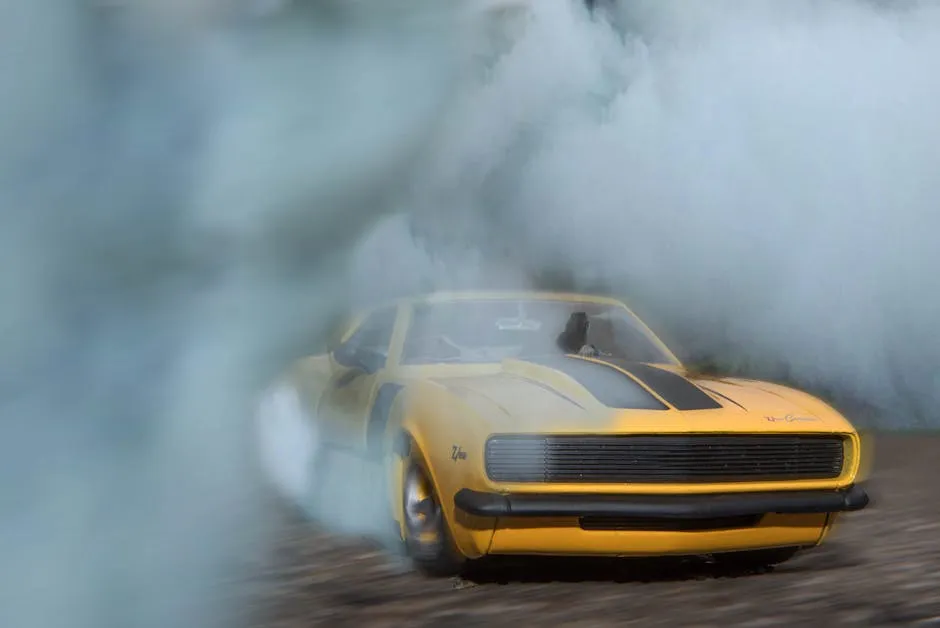
Common Causes of Smoke Under the Hood
When you see smoke emanating from your car’s hood, it’s a serious concern. Identifying the cause quickly can save you from costly repairs. Here are some common causes of smoke under the hood.
Overheating Engine
An overheating engine is one of the most frequent culprits behind smoke. When the engine temperature rises too high, it can cause various components to fail. This leads to smoke as coolant or oil seeps onto hot surfaces.
Several factors can cause overheating:
- A malfunctioning cooling system may fail to regulate temperature.
- A damaged radiator can leak coolant, causing the engine to overheat.
- Coolant leaks can occur from hoses or gaskets that have degraded over time.
Statistics show that overheating engines account for a significant number of vehicle breakdowns. In fact, around 30% of all engine failures are due to overheating. Catching this issue early is crucial to prevent severe engine damage.
To keep your engine cool, consider using a high-quality Engine Coolant. It helps maintain optimal temperature levels and prevents overheating. Trust me, your engine will thank you!

Oil Leaks
Oil leaks are another common reason for smoke. When oil leaks from the engine, it can drip onto hot components, leading to smoke as it burns.
Typical sources of oil leaks include:
- A damaged oil filter can lead to oil escaping.
- Faulty gaskets may fail to seal properly, allowing oil to seep out.
Ignoring oil leaks can have dire consequences. Low oil levels can result in poor lubrication, causing engine wear and potential failure. It’s essential to address oil leaks promptly to maintain engine health.
And while you’re at it, don’t forget to grab an Oil Filter Wrench. It makes changing your oil filter a breeze!

Electrical Issues
Electrical problems can also lead to smoke under the hood. Short circuits or damaged wiring can generate heat, resulting in smoke.
Symptoms of electrical failures include:
- A burning plastic smell may indicate wires are melting.
- Flickering lights can signal an electrical issue.
These problems pose significant risks. An electrical failure can lead to a fire, endangering both you and your vehicle. Always take electrical smoke seriously and seek professional help if you suspect an issue.

Fluid Leaks (Coolant, Transmission Fluid, etc.)
Fluid leaks are a common cause of smoke under the hood. When fluids, such as coolant or transmission fluid, leak onto hot engine components, they can quickly vaporize and produce smoke. This can create a frightening situation, especially if you’re not sure what’s causing it.
Regular fluid checks are vital. Ensuring your vehicle has adequate fluid levels helps maintain engine health and performance. Neglecting fluid maintenance can lead to severe damage over time.
Identifying fluid leaks is crucial for keeping your car running smoothly. Look for puddles under your vehicle or spots on your driveway. You can also check fluid levels in the reservoir or dipstick. If you notice any drops in fluid levels or suspicious stains, it’s time to investigate further.
And while we’re on the topic of fluids, don’t forget to keep a handy Car Engine Oil in your garage. It’s like the lifeblood of your engine!

Fuel System Problems
Fuel system issues can also lead to smoke. For instance, malfunctioning fuel injectors might cause excess fuel to enter the engine. When this happens, it can burn improperly, resulting in smoke.
Common signs of fuel system problems include unusual smells, such as a strong gasoline odor. If you notice this, it’s essential to address it quickly.
To diagnose fuel system issues, pay attention to your vehicle’s performance. Is it stalling or struggling to start? If so, these could be indicators of a malfunction. You might also want to check for fuel leaks around the injectors or fuel lines. Regular maintenance, including Fuel Injector Cleaner, can prevent these problems and keep your car running efficiently.

Blue or Gray Smoke
Seeing blue or gray smoke from your car? This usually means your engine is burning oil. It’s a sign that something may be wrong. The most common causes include worn seals or damaged piston rings. These issues can allow oil to seep into the combustion chamber.
Always check your oil levels if you notice this smoke. Low oil can lead to more severe engine problems down the line. Keeping an eye on your oil can save you from costly repairs.
To make checking your oil easier, consider using a Oil Drain Pan. It’s an excellent tool for DIY oil changes!

Black Smoke
Black smoke is another warning sign. It often indicates incomplete combustion in the engine. This typically happens when there’s too much fuel and not enough air. Possible causes include faulty fuel injectors or a malfunctioning fuel pressure regulator.
If you smell gasoline along with the black smoke, it’s a clear indicator of a fuel issue. This could lead to poor engine performance and reduced fuel efficiency. Don’t ignore this warning; addressing it quickly can prevent further damage.

What to Do If Your Car Is Smoking
Pull Over Safely
First things first: pull over as soon as it’s safe. Shutting off the engine is critical. This prevents further damage and allows you to assess the situation. Take a moment to breathe and gather your thoughts. Panic won’t help, but a clear head will.
Inspect the Situation
After stopping, look for any visible signs. Check if there’s smoke coming from specific areas. Is the smoke accompanied by unusual smells? Pay attention to your dashboard. Are there warning lights illuminated?
Monitor your temperature gauge. If the engine is overheating, you need to take action quickly. Checking oil pressure is also crucial. Low oil pressure can indicate more significant problems ahead.
With a quick visual inspection, you can gather valuable information about the issue. If you see fluid leaks or unusual gauges, it’s time to call for help. Don’t take risks with your safety or your vehicle’s health.

Seek Professional Help
Noticing smoke under your hood? It’s vital to consult a professional mechanic immediately. Ignoring the problem can lead to severe engine damage and costly repairs down the road. A small issue today can escalate into a hefty bill tomorrow.
When you reach out to a mechanic, clear communication is key. Start by describing the symptoms you’ve observed. Mention the color and smell of the smoke. Did you notice any unusual sounds or warning lights? Providing as much detail as possible will help them diagnose the issue faster.
Don’t hesitate to ask questions about the repair process and costs. Understanding the situation will ease your mind and ensure you make informed decisions regarding your vehicle.
And while you’re on the phone, it might be a good idea to mention that you have a Portable Jump Starter in your trunk. You never know when it might come in handy!

Preventive Measures
Regular maintenance is your best line of defense against smoke-related issues. Schedule routine check-ups with your mechanic to keep your vehicle in top shape. This often includes fluid checks, filter changes, and inspections of key components.
Monitor your fluid levels regularly. Check the oil, coolant, and transmission fluid levels. If you notice any drops, investigate further. Leaks can cause significant problems if left unaddressed.
Inspect your vehicle for signs of wear and tear. Look for any leaks under your car or stains on the driveway. Using high-quality fluids and parts can also make a difference. They often perform better and last longer, reducing the risk of issues down the line.
Speaking of high-quality, consider investing in a Bluetooth OBD2 Scanner. It can help you diagnose problems quickly and efficiently, allowing you to stay ahead of potential issues.

Taking these preventive measures can save you from unexpected smoke incidents and keep your car running smoothly for years.
Conclusion
In summary, smoke under your car’s hood is a serious concern that shouldn’t be ignored. Identifying the cause early can save you from costly repairs and extensive damage. Regular maintenance checks and prompt action are essential in addressing any smoke issues. Stay informed about your vehicle’s health, and don’t hesitate to consult a professional if you notice anything unusual. Your car will thank you for it!
Don’t forget to keep a Car Maintenance Logbook handy to track all your vehicle’s maintenance history. It’s a great way to keep everything organized!
Please let us know what you think about our content by leaving a comment down below!
Thank you for reading till here 🙂
All images from Pexels




